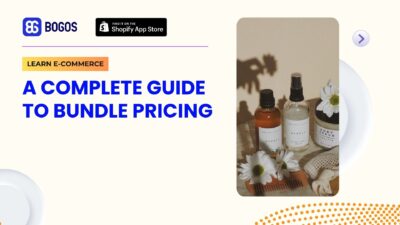
A Complete Guide to Product Bundle Pricing for Shopify Stores in 2025
Bundle Pricing is ubiquitous. You know when you have to buy a coffee machine with a bag of coffee...
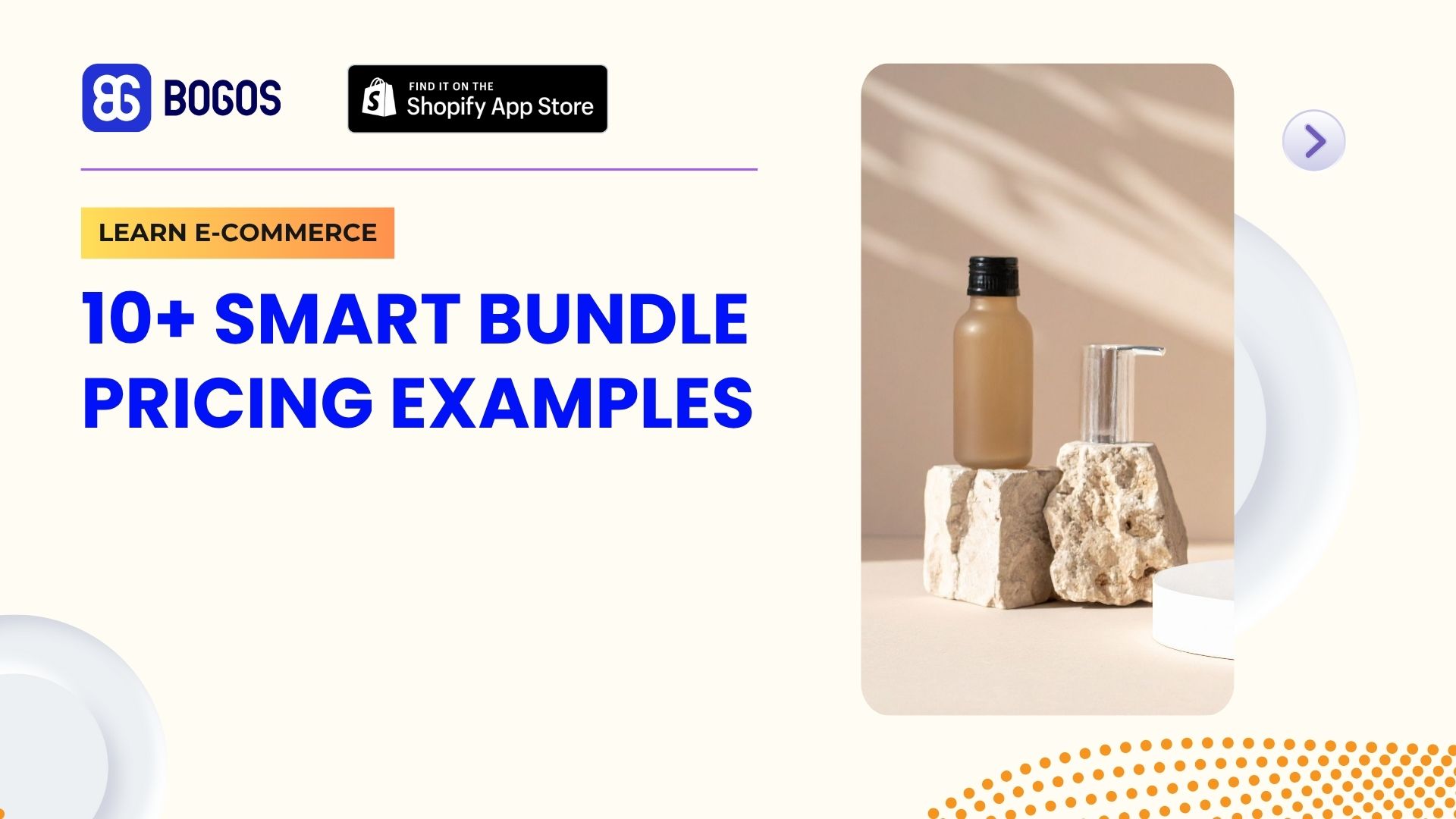
Digital Marketing Specialist
E-commerce in 2025 is noisier than ever, with shoppers overwhelmed by choices and brands competing for attention. That’s why more Shopify stores are leaning on product bundling. This tactic doesn’t just package items together, but also simplifies decisions for customers and creates more value in a single click.
Businesses using this approach see an average revenue rise of 30%, proving it’s more than a passing trend. This guide walks you through each bundle pricing examples, from pure and mixed bundles to gift sets, upsell offers, and subscription boxes, showing exactly how and when to use them in your store.
When it comes to bundle pricing, every strategy is based on two main models: pure bundling and mixed bundling. Nearly every other style you’ll see — from leader bundles to cross-sell sets — branches off from these two core models. Here’s how they work and why they matter.
Pure bundling locks products together. The only way to get them is as part of the set; no single-item purchases allowed.
A clear bundle example is the Dyson Airwrap. When you purchase it, you receive the styler, along with multiple barrels, brushes, and attachments, all in one package. You can’t just buy a single barrel on its own. The whole kit comes as a curated set.
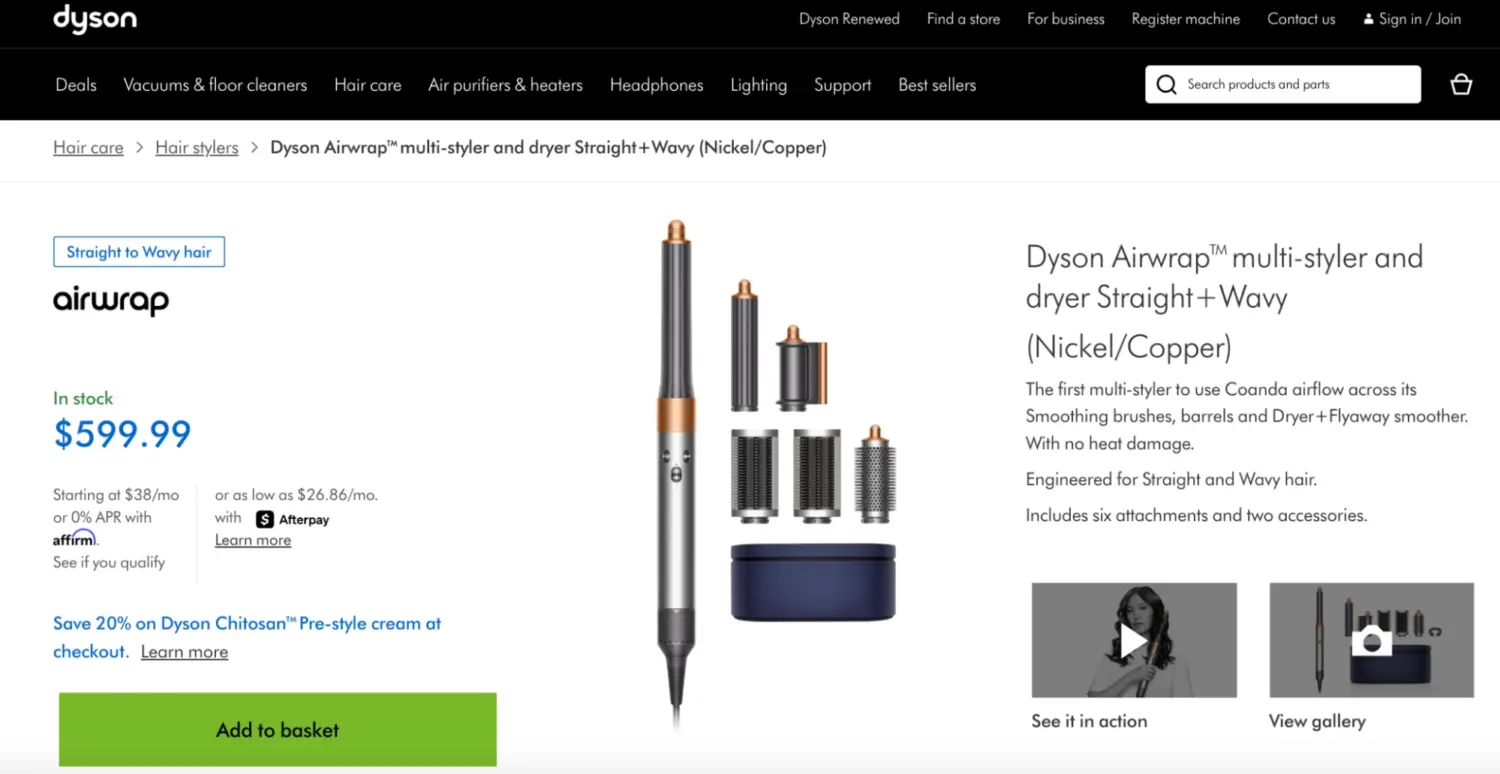
When is pure bundling the right choice?
Pure bundling works well for Shopify merchants selling items that are interdependent or positioned as “complete solutions.” It simplifies buying decisions and drives a higher perceived value, but it also removes flexibility for customers who want just one piece of the package.
Mixed bundling is all about flexibility. Products can be purchased individually or together as a bundle, often with a slight discount or bonus for choosing the set.
Kylie Cosmetics is one of the most apparent bundle pricing examples. Customers can purchase one lip kit shade for $35 or opt for multi-shade bundles at a lower per-item price. The bundle tempts shoppers with value, while the single option keeps the door open for those testing just one shade.
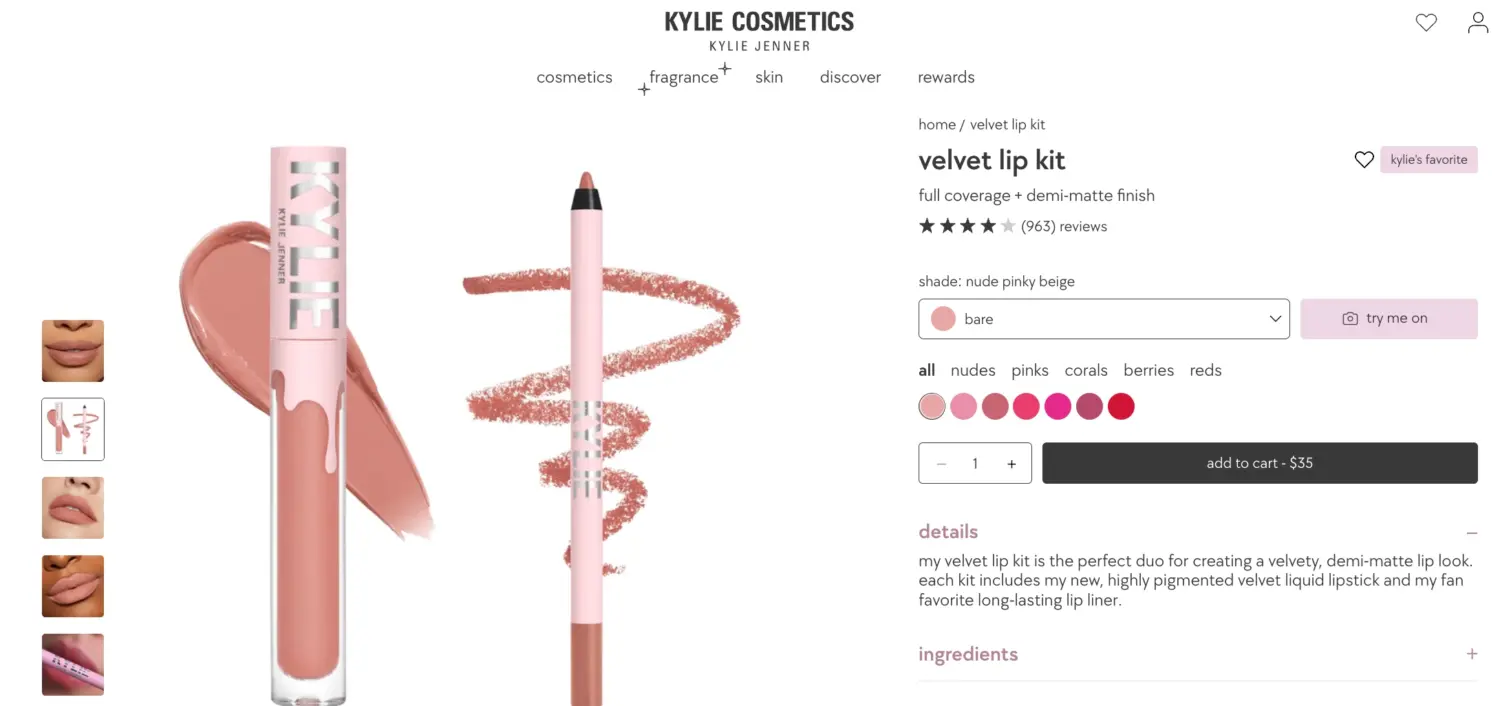
When is mixed bundling the right choice?
Mixed bundling is ideal for Shopify stores with versatile inventories where products that sell well individually but become even more attractive in sets. It encourages upsells without forcing commitment and allows you to serve customers with different budgets and buying habits.
With the basics covered, let’s break things down further. Here are 13 bundle pricing examples you’ll spot across Shopify stores, along with insights on how they actually work.
Bundle approach: Leader Bundling
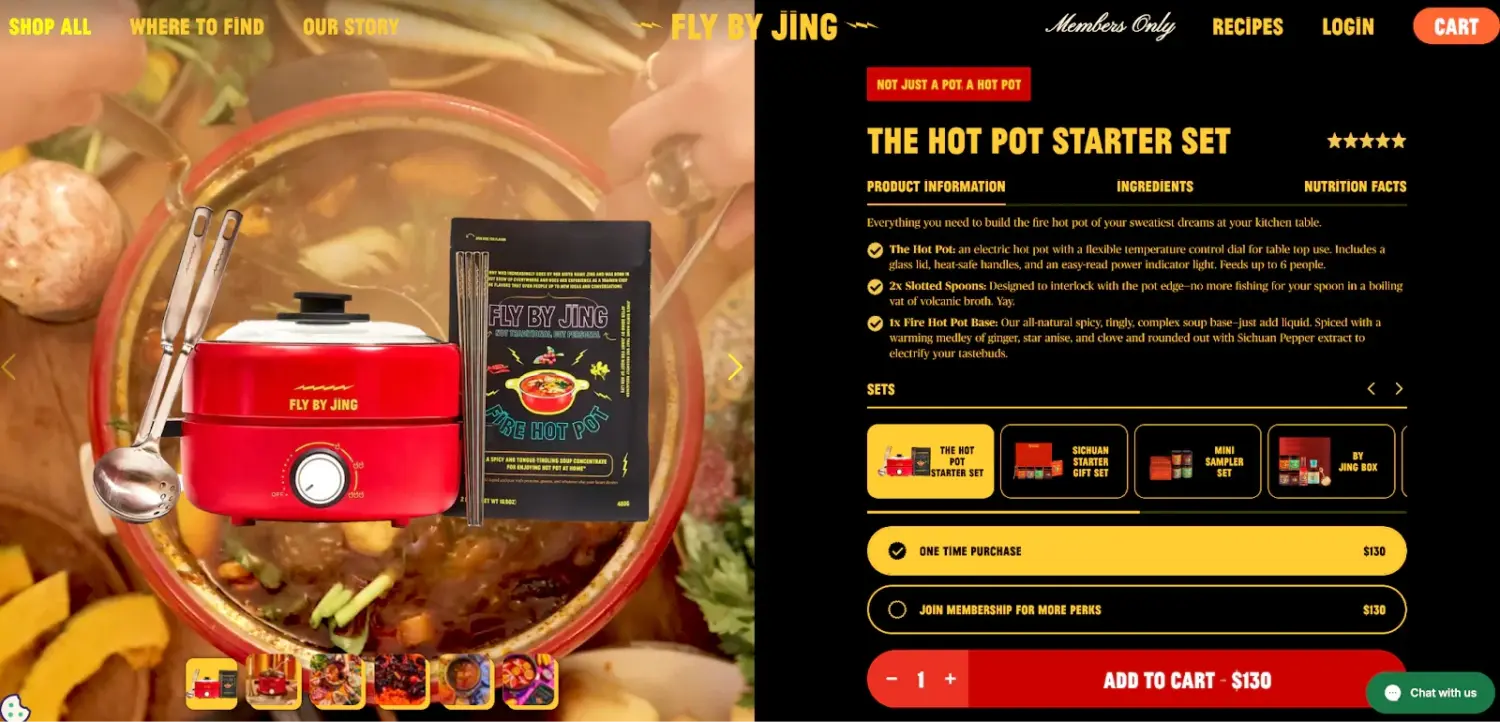
Fly By Jing’s bundle strategy revolves around a single hero: their vibrant red electric hot pot. Instead of simply listing the pot as another kitchen gadget, they packaged it with broth bases, slotted spoons, and chopsticks, creating “The Hot Pot Starter Set.”
This instantly transforms a one‑off product into an at‑home dining experience. The bundle doesn’t just sell a pot; it sells the promise of a full hot pot evening, with everything ready out of the box. This is a textbook bundle pricing example for Shopify merchants to study.
Why it works for you: Leader bundling is about letting your strongest product carry the offer. Fly By Jing didn’t pad the bundle with filler; they added only items that make the pot easier and more exciting to use. If you have a hero product, start there and build a bundle around it that feels essential, not optional.
Bundle approach: Upsell Bundling
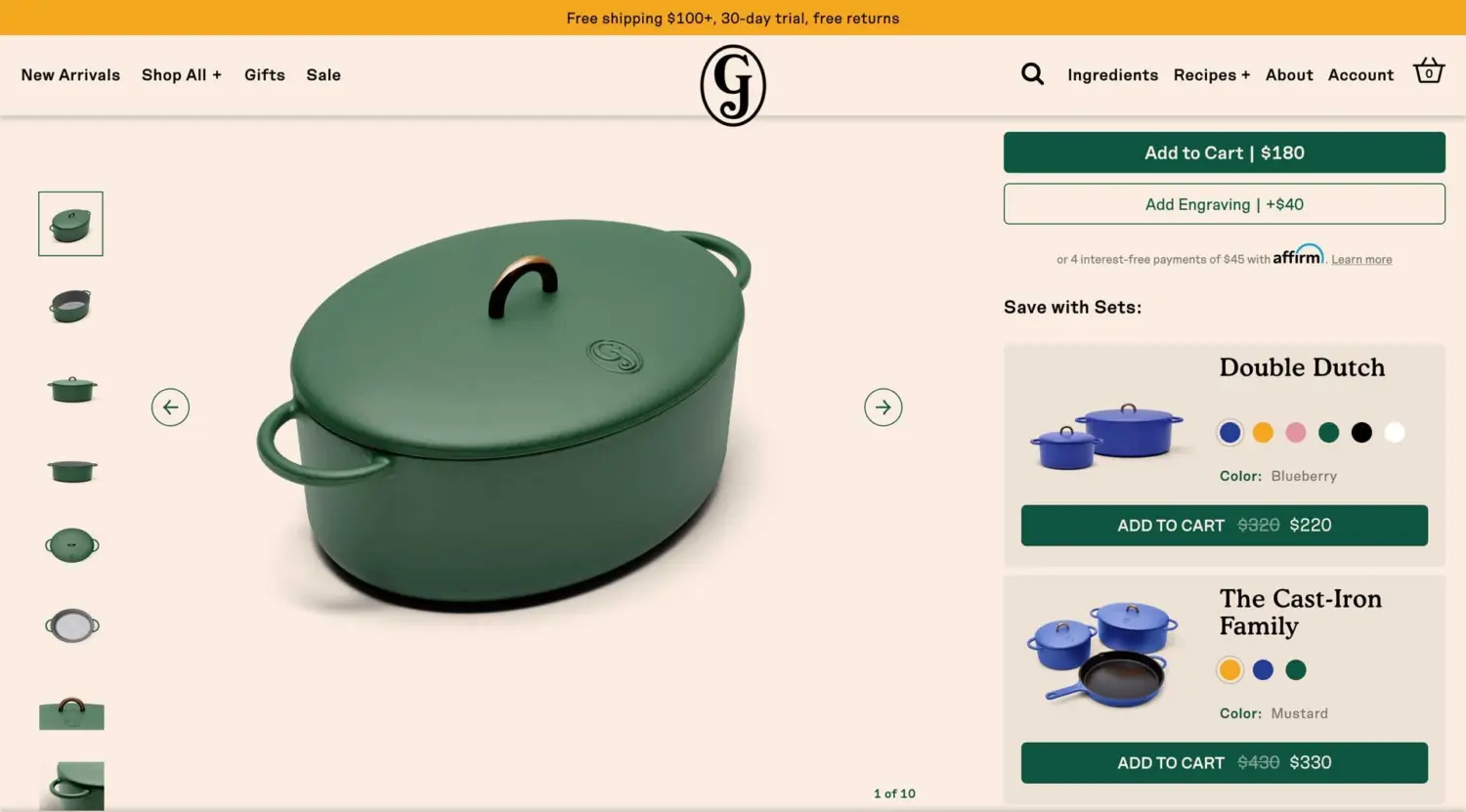
Great Jones takes every Dutch oven listing and gently nudges customers toward more. On the page for a single pot, they highlight cookware sets, framing them as a way to “save with sets” rather than just upselling. It feels less like a pitch and more like a recommendation from a friend — “If you’re investing in this pot, you might want the rest of the collection too.”
Why it works for you: Upsell bundling isn’t about slapping on a pop‑up. It’s about timing and tone. Great Jones suggests the upgrade when shoppers are already committed, making it feel intelligent and logical. If you try this, present the upsell as a better deal or a complete solution, rather than as an additional expense.
Bundle approach: Cross‑Sell Bundling
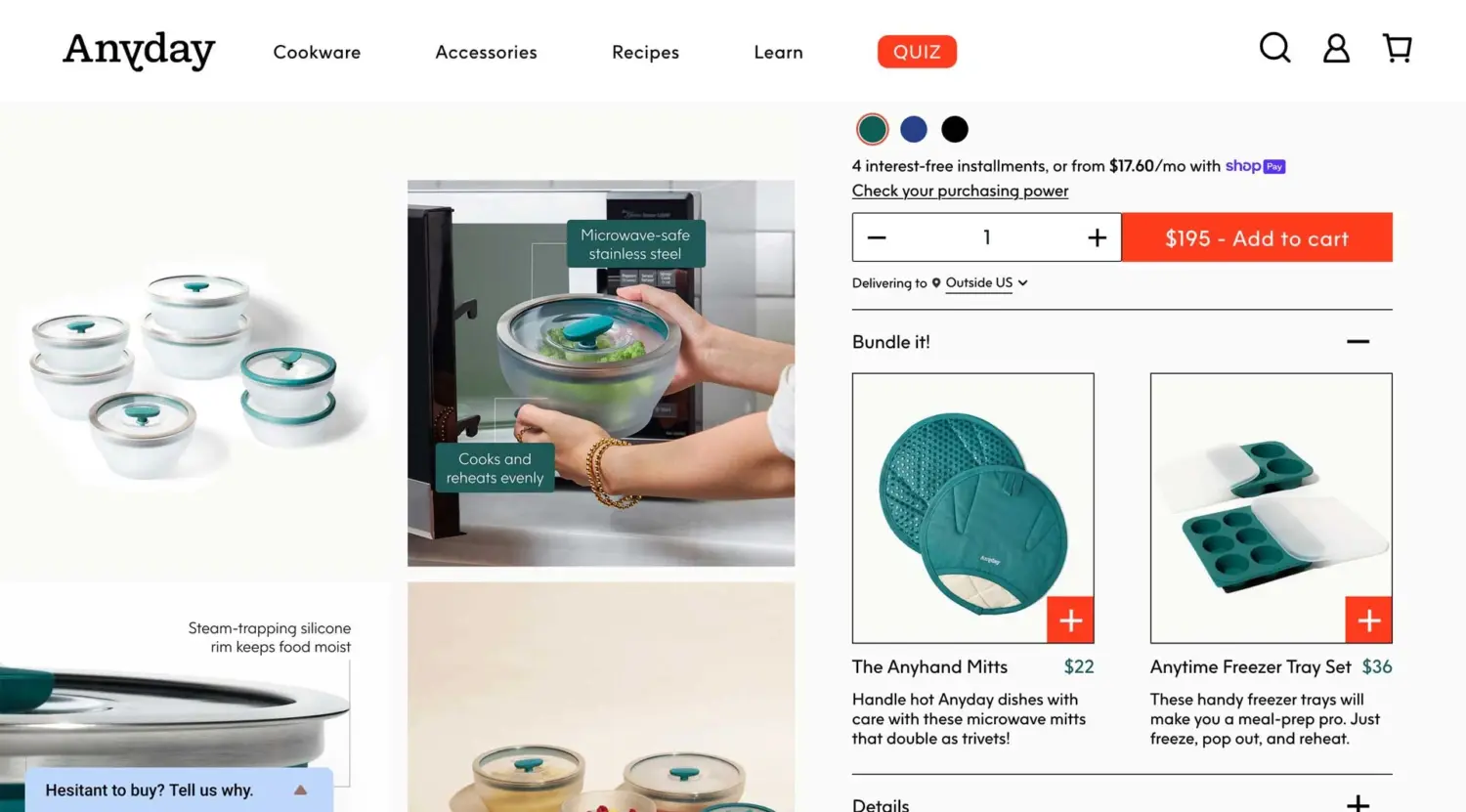
Anyday embeds smart cross‑sells right on their product pages. When you add a bowl, they suggest mitts for lifting it out of the microwave or freezer trays for prepping ahead. These are items that genuinely enhance the main product’s usability. This bundle pricing example shows how even small add-ons can improve usability and boost sales.
Why it works for you: Cross‑selling is at its best when it feels helpful, not pushy. Anyday has mastered that balance by making each add‑on relevant to the main item in the cart. Think: “What’s the one thing that would make this purchase more useful?” and bundle that.
Bundle approach: Tiered Service Bundling
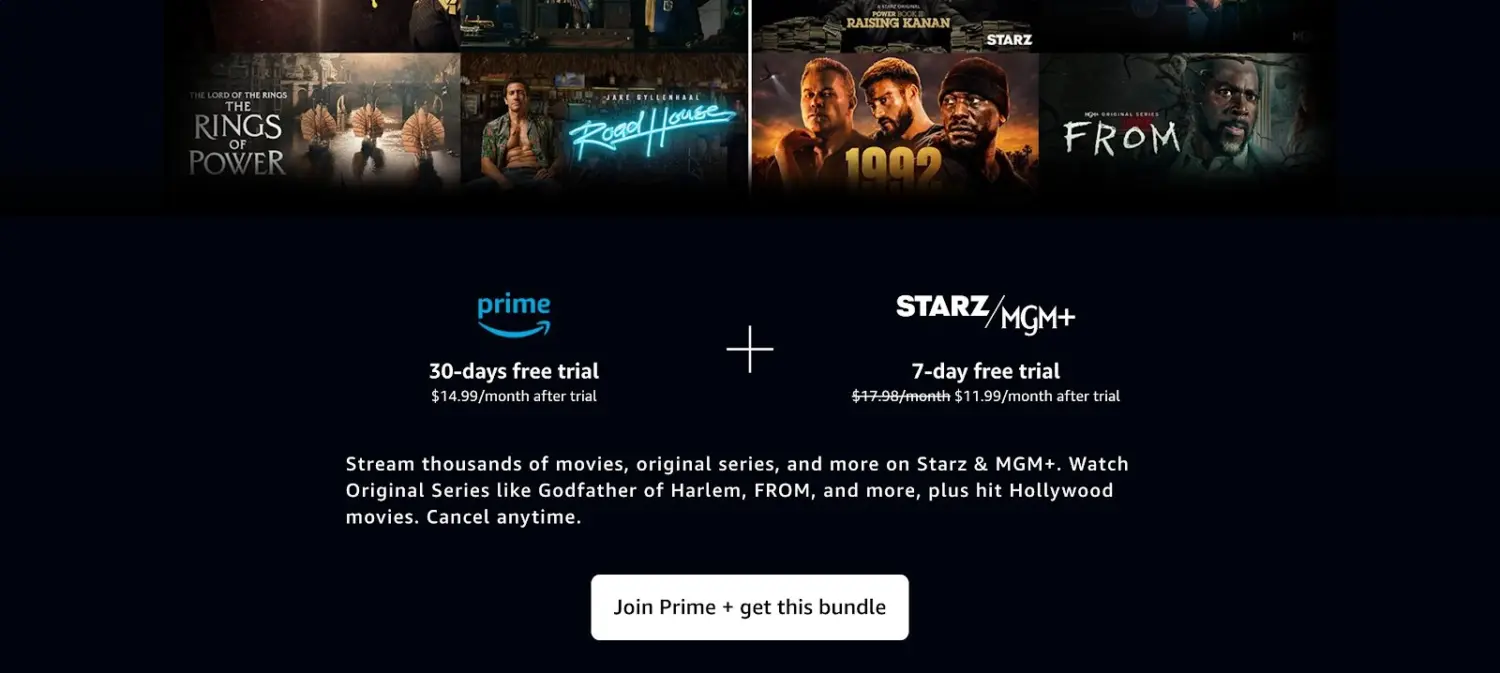
Amazon makes bundling work beyond physical goods by pairing Prime with Starz/MGM+ trials. Prime members see an option to add Starz under one bill, with no extra setup. The offer feels like an “unlock” — you’re already paying for Prime, why not stack another perk for less?
Why it works for you: Tiered service bundling is a reminder that Shopify merchants with memberships or subscription perks can bundle too. Consider what upgrades or extras can be added seamlessly, so customers feel like they’re enhancing their experience, not getting tangled in another subscription headache.
Bundle approach: BOGO Bundling
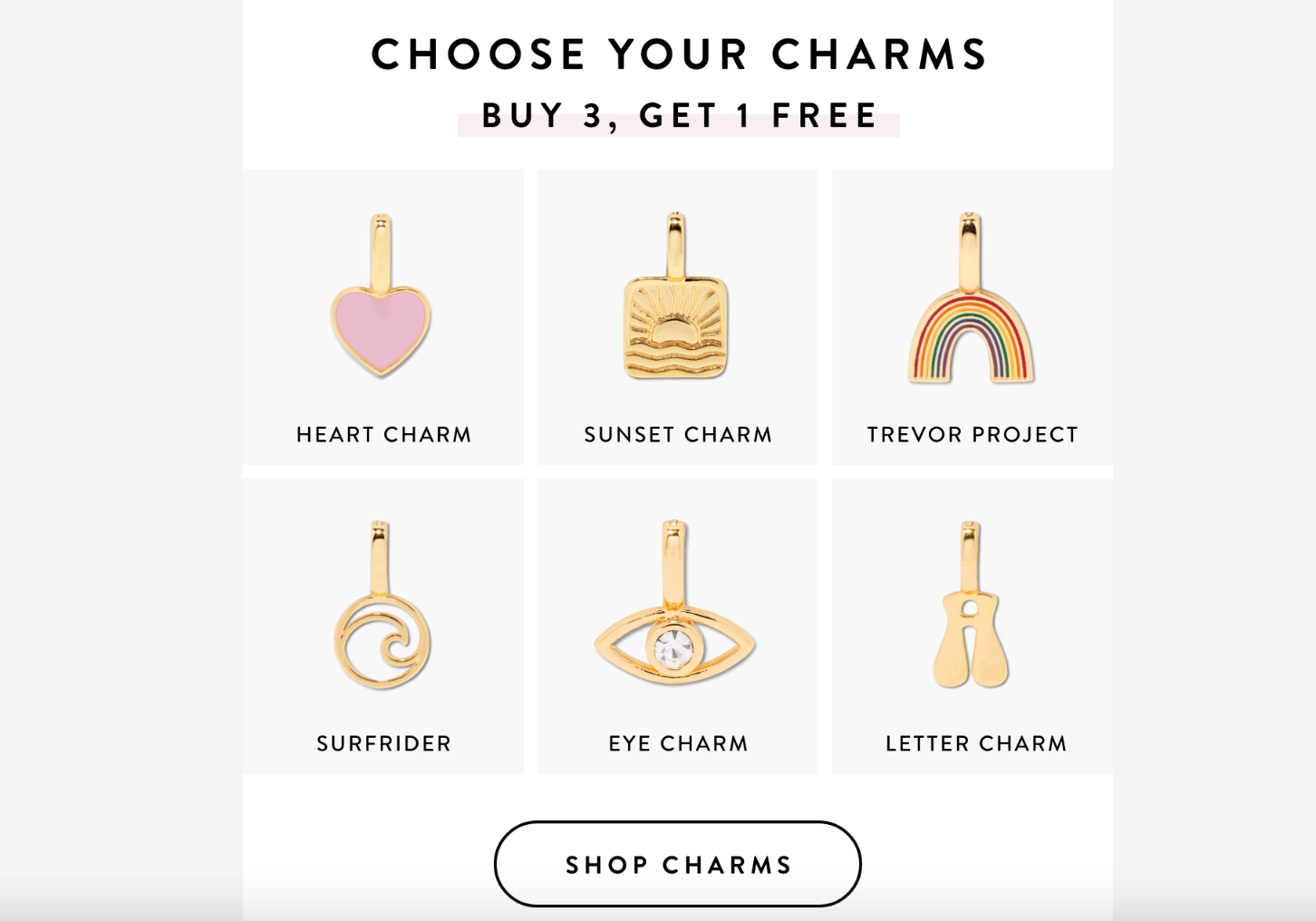
Pura Vida keeps it classic with a jewelry BOGO: buy three charms, get one free. It’s clean, direct, and visually clear on the page. The “free” charm is highlighted, making customers feel rewarded for adding more to their cart.
Why it works for you: BOGO bundling works because it feels like a win. Don’t overcomplicate it. Use simple triggers (“buy three, get one”), choose products with good margins, and ensure the “free” part is prominent.
Bundle approach: Build Your Own Bundle (BYOB)
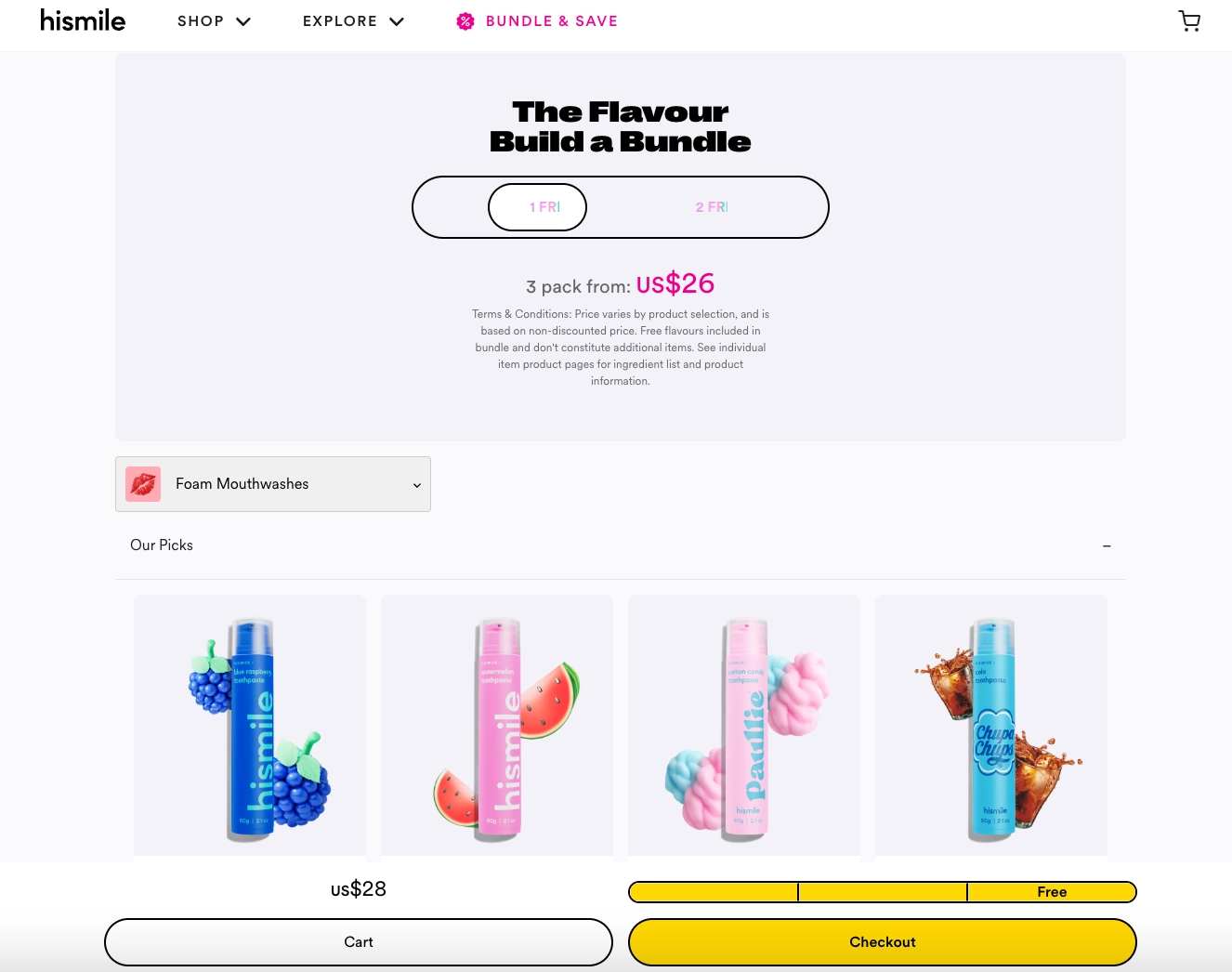
Hismile invites shoppers to “build their own” mouthwash bundle, allowing them to select flavors to create a 3-pack. Customers feel in control. They save money but also choose precisely what they’ll get. That choice feels personal, which makes the purchase stickier.
Why it works for you: BYOB is perfect when you have variations. Hismile doesn’t overwhelm; they limit options, making it fun, not stressful. If you try this, give customers enough variety to feel custom, but not so many choices that they freeze up.
Bundle approach: Subscription + Bundle Pricing
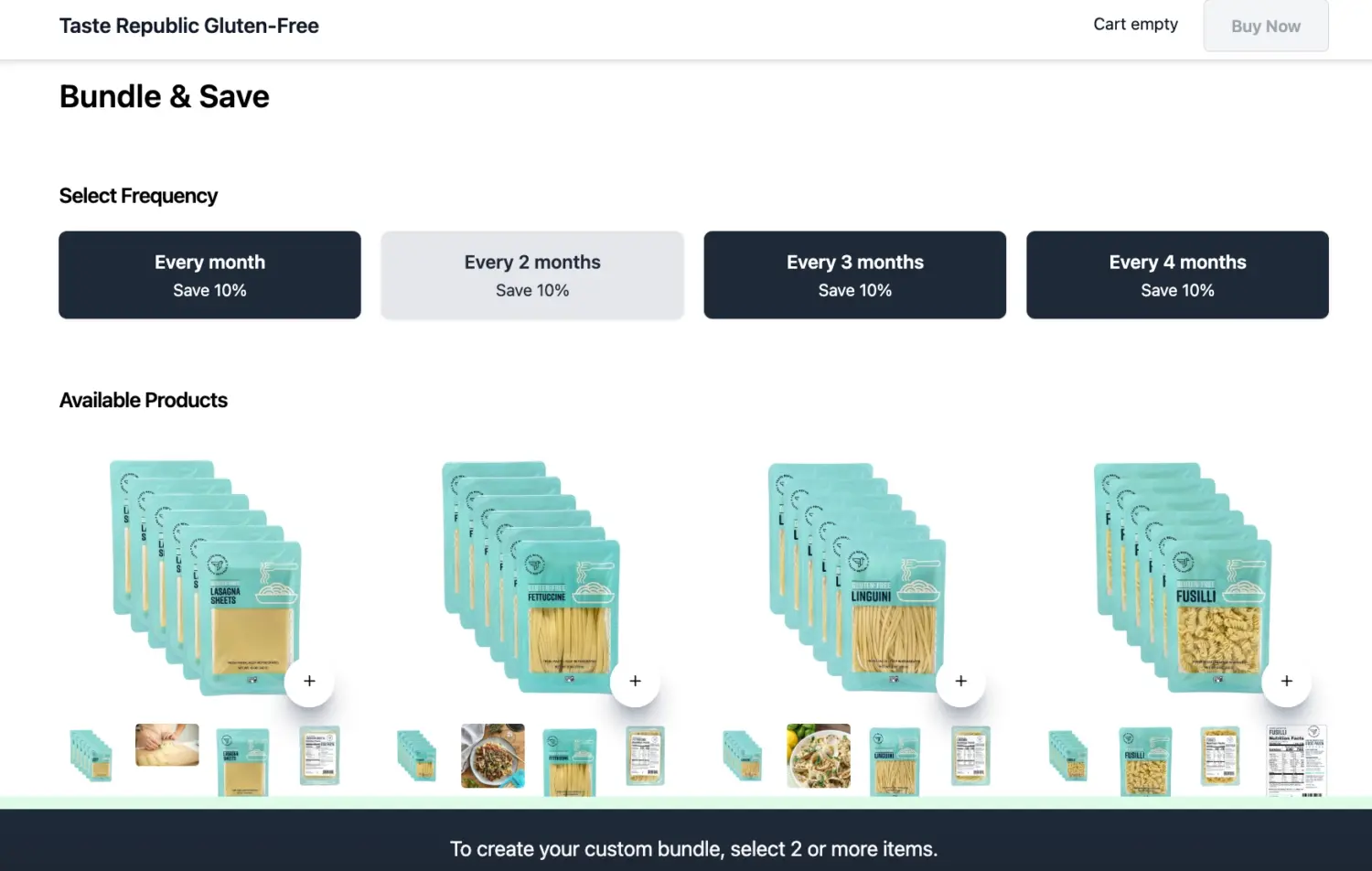
Taste Republic combines bundles with subscriptions, offering gluten-free pasta packs on a recurring delivery schedule. Customers save 10% and know their pantry won’t run dry. It’s a “bundle once, benefit forever” model.
Why it works for you: Bundling consumables with a subscription is a powerful approach. Buyers get a deal and convenience, and you get predictable revenue. Be crystal clear about what’s included and how often it ships. Trust is what makes the model work.
Bundle approach: Frequently Bought Together Bundle
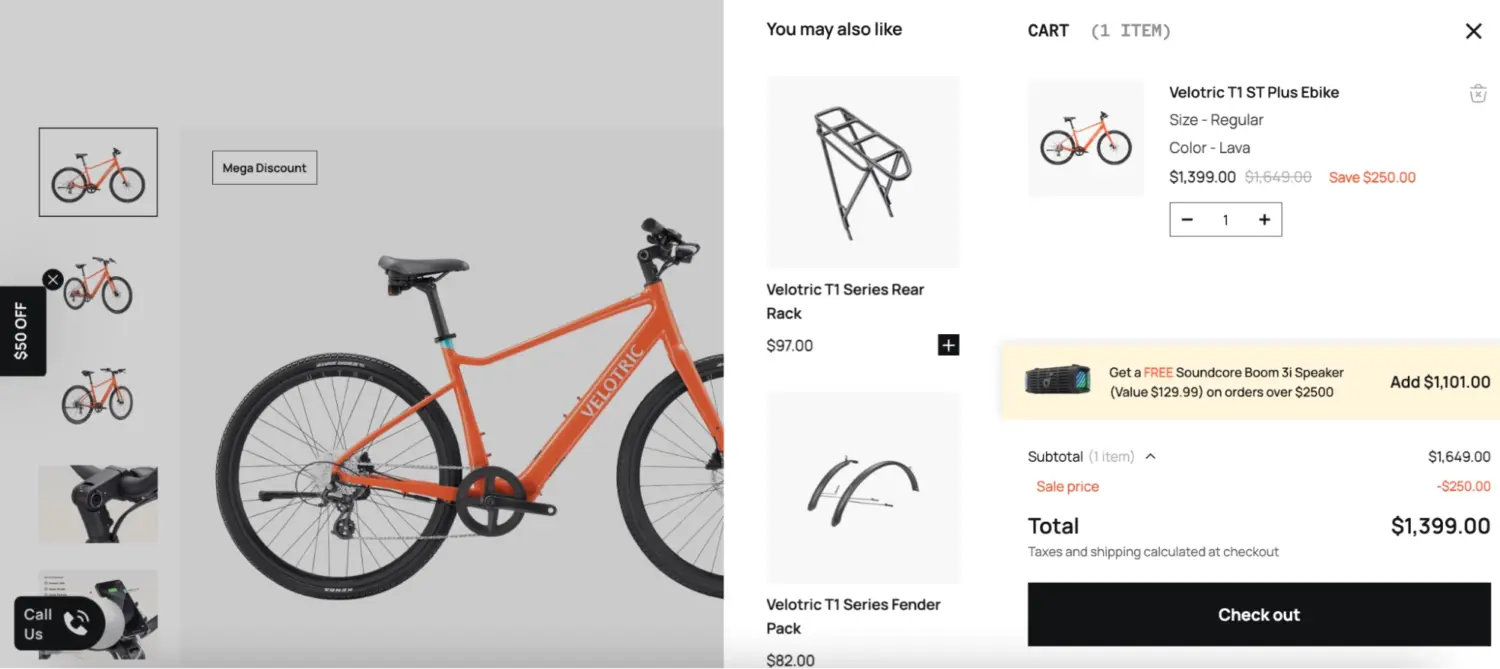
Velotric doesn’t just sell an e‑bike; they show accessories that “other buyers added”: racks, fenders, even speakers. These are obvious and logical add-ons. Shoppers see what others bought and think, “I’ll grab that too.”
Why it works for you: FBT bundling works when the suggestions feel inevitable. If you’re showing unrelated products, it feels like a cash grab. Keep the logic clear, and buyers will happily expand their order.
Bundle approach: Starter Kit Bundle
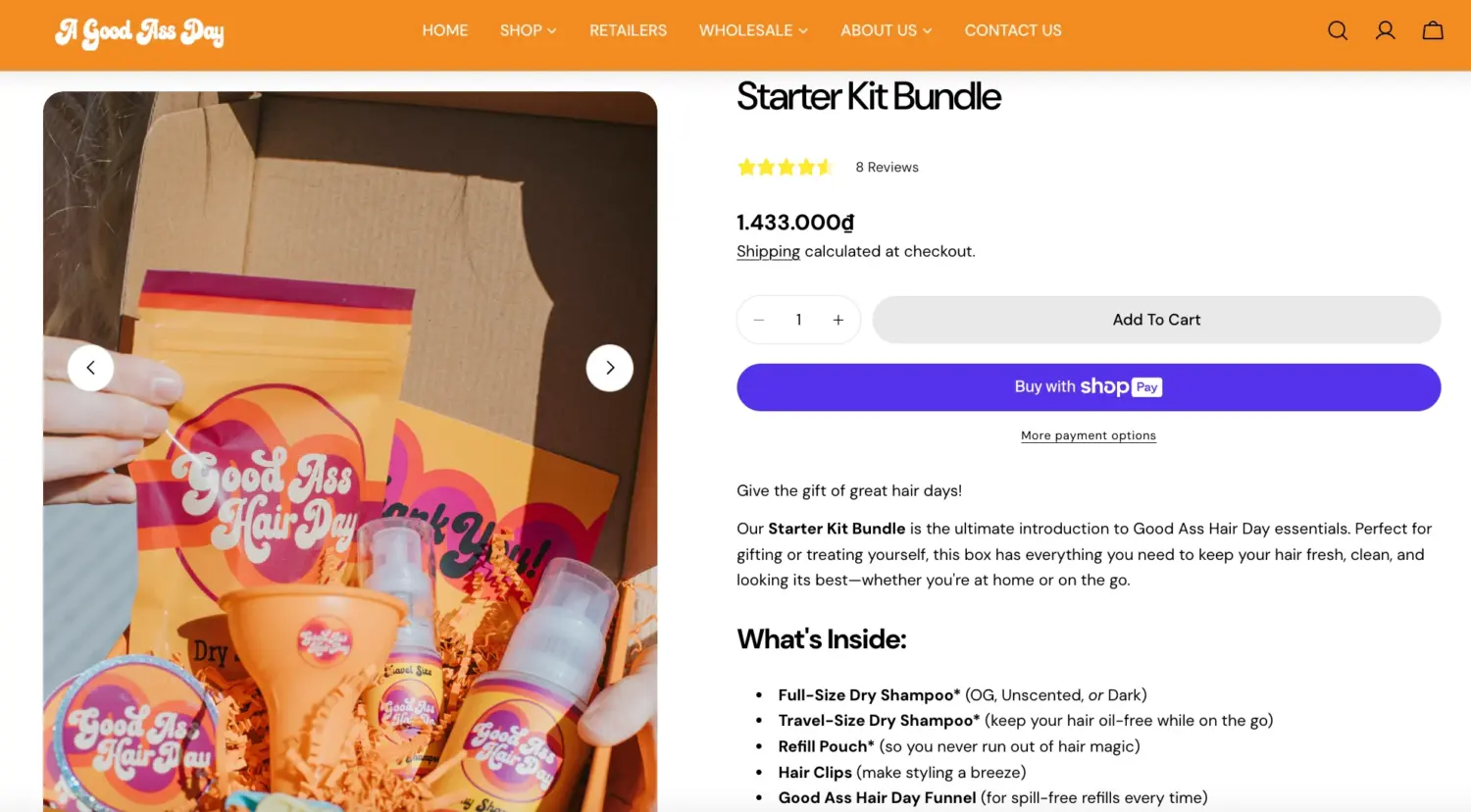
Good Ass Day’s Starter Kit gives buyers everything for a “good hair day” — full‑size spray, minis, clips, refills. It’s the easiest “add to cart” experience ever for a new customer, as they don’t have to think; they get the whole experience in one box.
Why it works for you: Starter kits work when they feel complete. Make them a “no‑brainer” choice for first‑time buyers by covering all essentials, so they start their journey with your brand in the best way.
Bundle approach: Seasonal Bundle
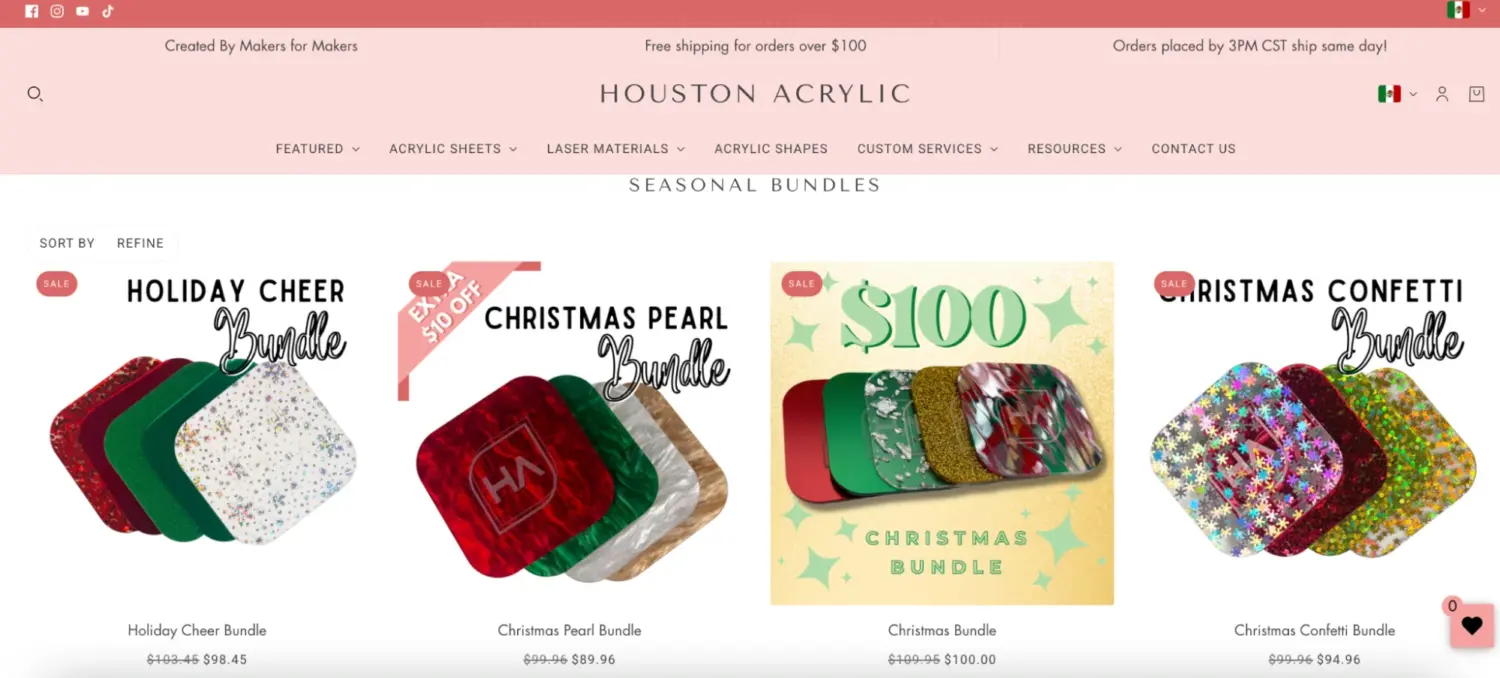
Houston Acrylic curates seasonal acrylic sheet bundles for holidays like Christmas. Limited‑time colors create urgency and make holiday shopping brainless for crafters. They just click and go.
Why it works for you: Seasonal bundling taps into natural buying spikes. Stock smartly (don’t overbuy, don’t undersupply), and you can ride the seasonal rush without the leftover regret.
Bundle approach: Subscription + Variety Pack
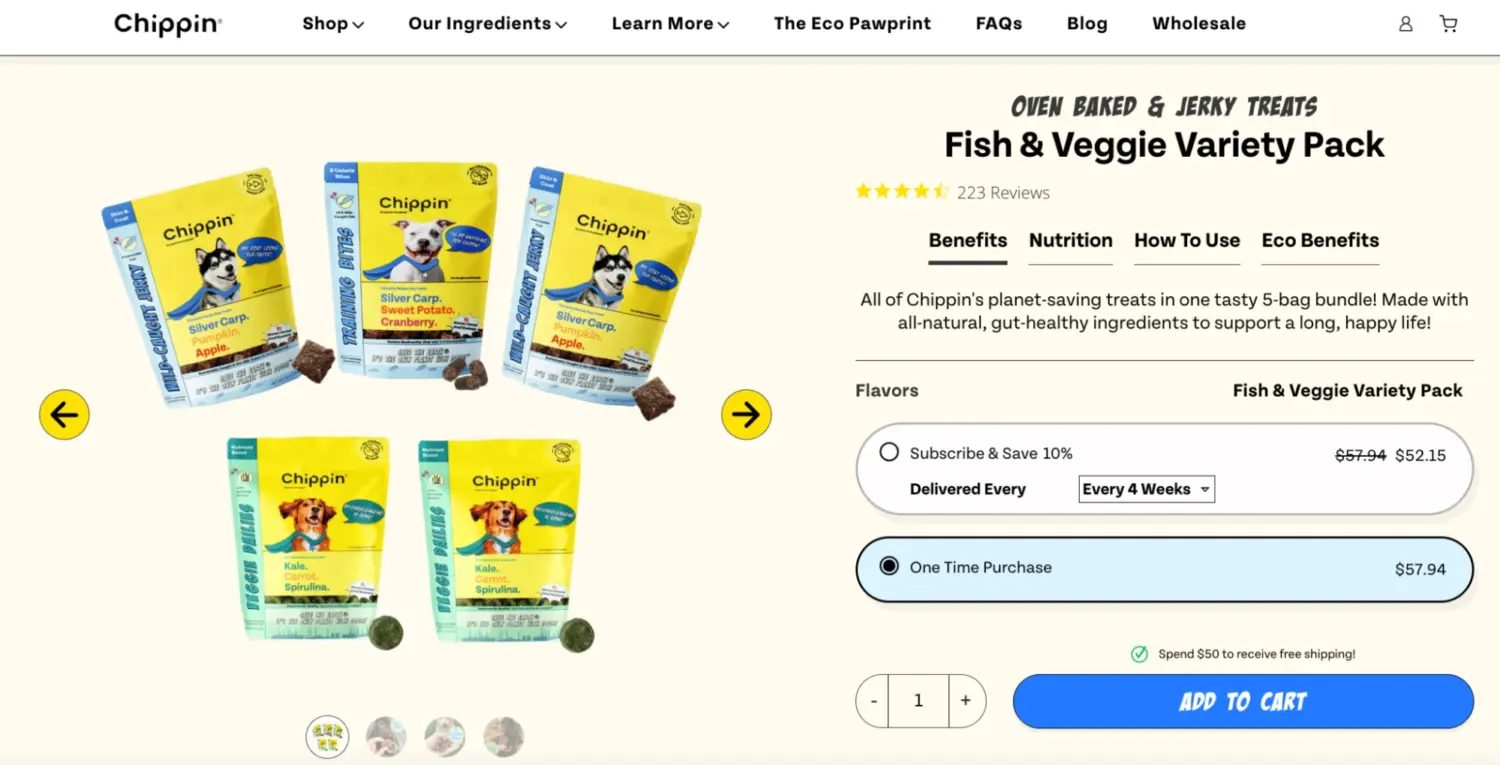
Chippin combines sustainability with wise bundling. Their Fish & Veggie Variety Pack includes five different dog treat flavors in one bundle, making it easy for pet owners to try the full range without committing to a single SKU. This is another great bundle pricing example for consumable goods.
On top of that, they offer a “Subscribe & Save 10%” option, turning a one-time purchase into an ongoing delivery. This combo ensures pets stay stocked up while Chippin secures steady, predictable revenue.
Why it works for you: If you sell consumables (food, supplements, or skincare), pair variety bundles with a subscription plan. It reduces friction for customers (eliminating the need to reorder constantly) and generates recurring income you can rely on.
Bundle approach: Tiered Multi‑Pack Bundling
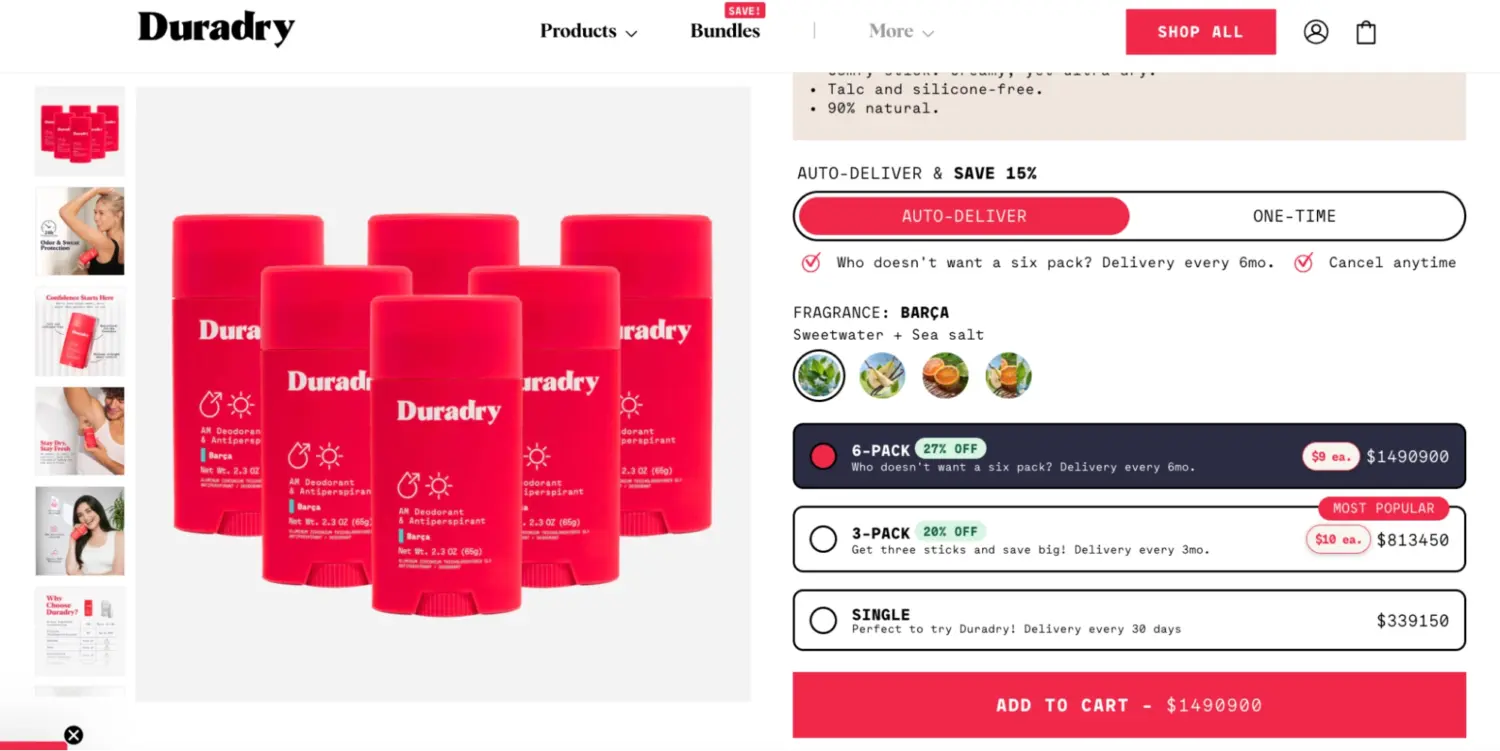
Duradry sells deodorant in singles, 3‑packs, and 6‑packs — each level offering a bigger discount. Add an “auto‑deliver” option and suddenly, buying six sticks feels like the obvious, smarter choice.
Why it works for you: Tiered bundling makes “buying more” feel intelligent, not indulgent. Set your price breaks so the upsell is natural: “Why not grab six if it’s cheaper per stick?”
Bundle approach: Curated Style Box
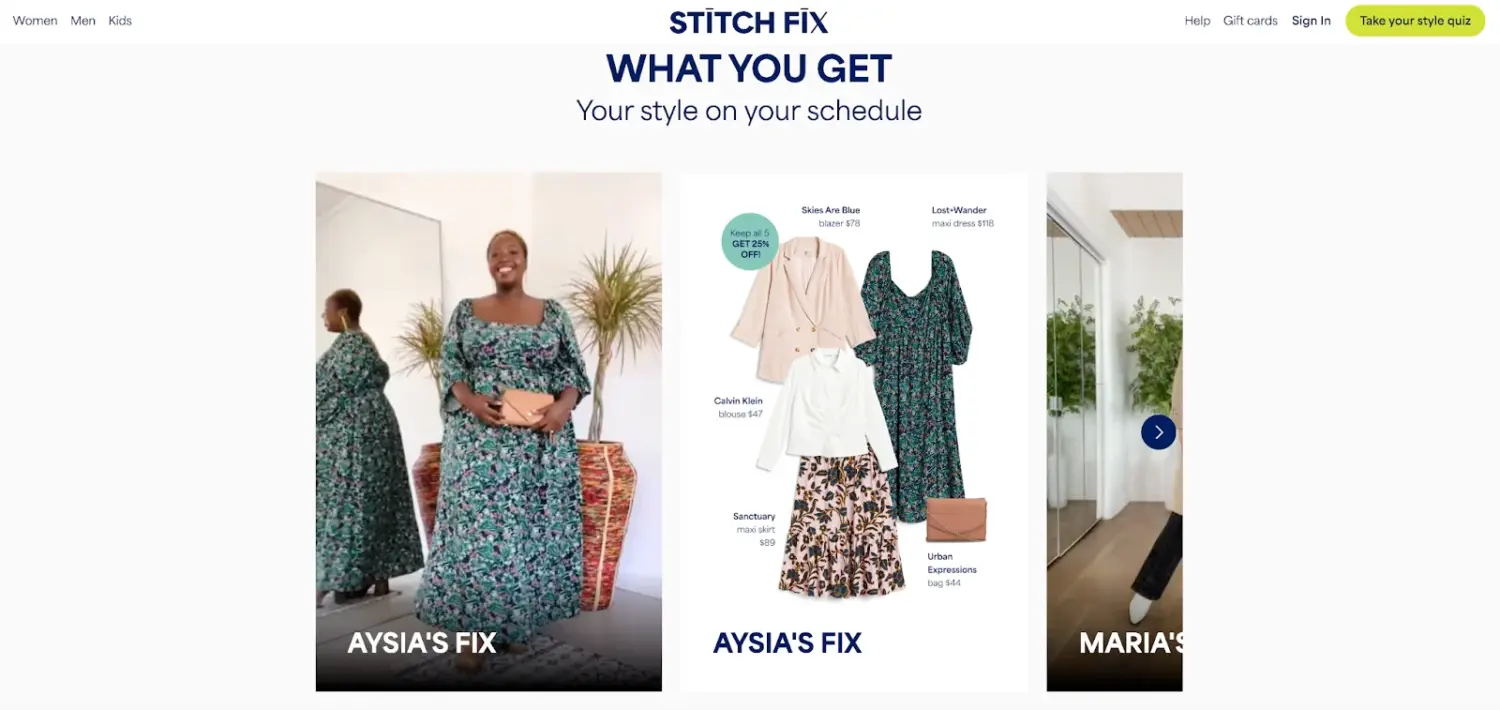
Stitch Fix sends a box of five curated pieces, and you can knock 25% off if you keep all of them. It turns a shopping chore into a stylist experience: no wandering racks, just outfits that work together.
Why it works for you: Curated bundles sell because they solve a problem. Make it clear what the bundle does for the buyer (builds outfits, stocks their pantry, sets up their kitchen), and they’ll happily buy the whole solution, not just one piece.
From fresh flower deliveries to subscription meal kits, Shopify brands are utilizing bundles in innovative ways to increase order values and streamline the purchasing experience. These five case studies demonstrate how various bundle pricing examples are implemented in real-world stores and the lessons merchants can apply.
👉 Explore all types of bundle pricing you can create on Shopify & set-up guide here: [2025] A Beginner’s Guide to Shopify Product Bundles
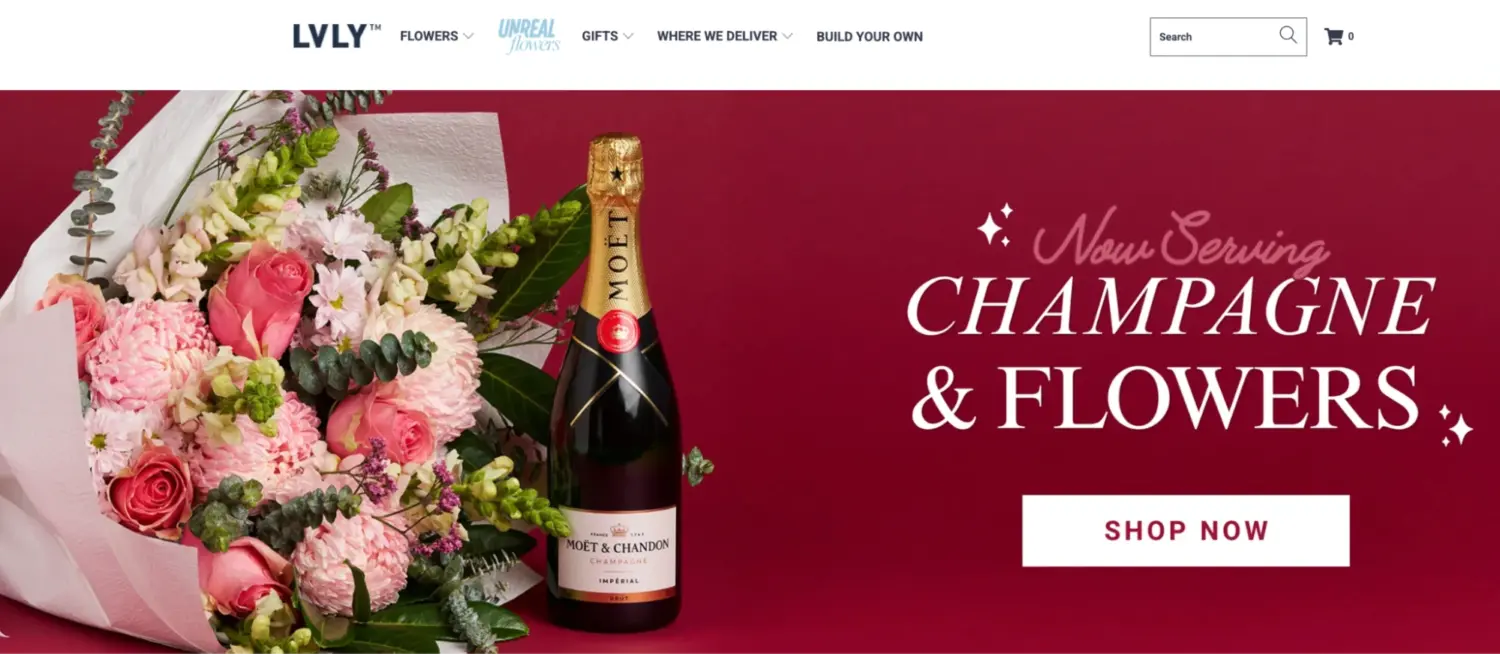
LVLY built its reputation on clever, cheeky flower delivery, but what really set them apart on Shopify Plus was how they turned simple bouquets into curated bundles. Instead of selling flowers alone, they paired them with candles, cards, and even mini champagne bottles — creating over 150+ gifting bundles that felt like complete experiences rather than just products.
These thoughtfully layered bundles, combined with upsell options like personalization and add-on gifts, made customers spend more with each order. The payoff was undeniable: a 66% jump in bundle SKUs, a 6% lift in average order value, and holiday sales that hit record highs.
Key lessons for merchants:
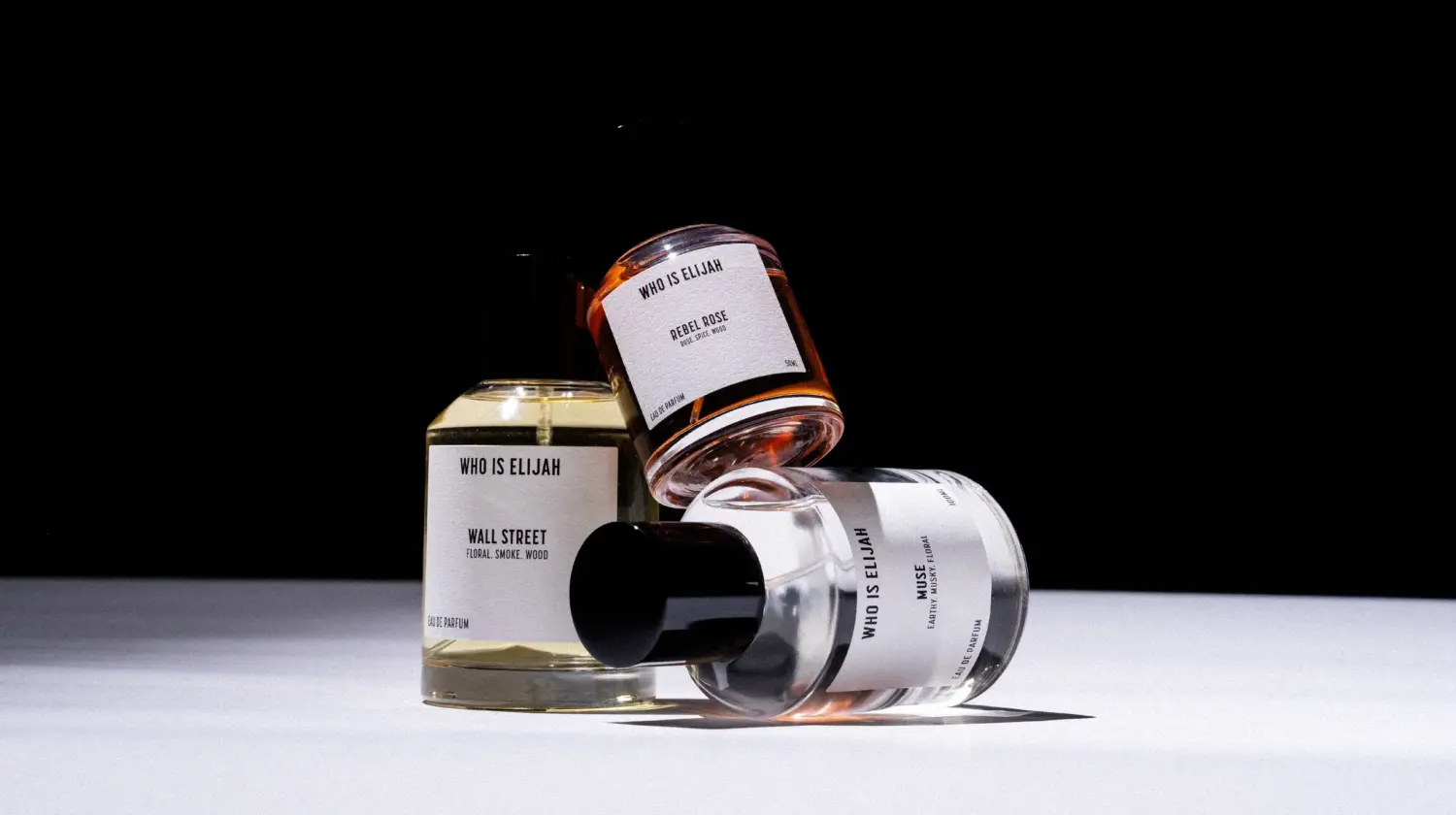
Luxury fragrance brand WHO IS ELIJAH used Shopify Plus to merge wholesale and direct‑to‑consumer sales under one roof. Beyond expansion stores and custom B2B pricing, their most brilliant move was using Shopify Bundles to power Black Friday offers and a Build Your Own Bundle feature.
Customers could mix and match 10ml scents without the brand creating dozens of new SKUs — a tactic that made bundling easy, flexible, and profitable.
Their impacts are: a 50% jump in international wholesale growth, a 46% higher AOV during Black Friday, and a 400% DTC revenue growth in just two years.
Key lessons for merchants:
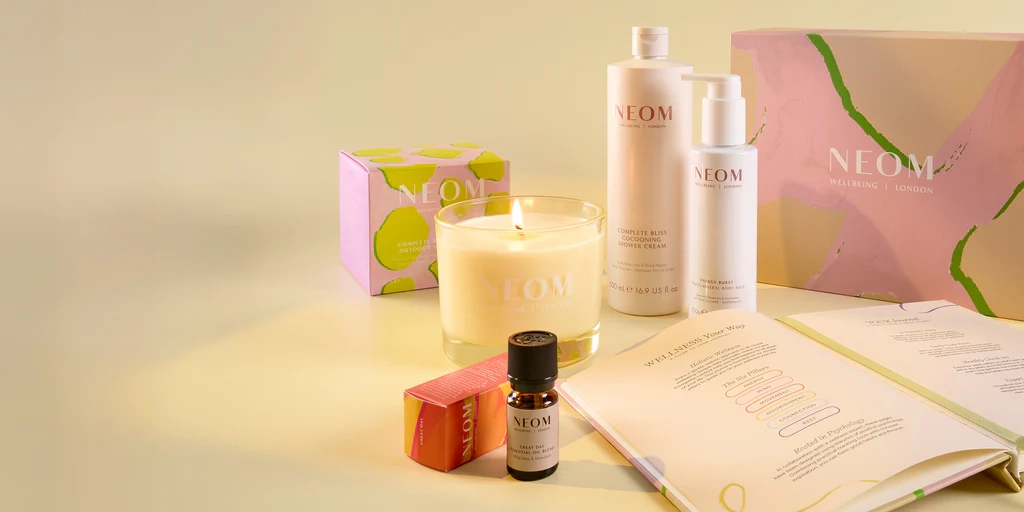
NEOM Wellbeing, known for their mood‑boosting oils and wellness products, recently leveled up on Shopify with a Gift Builder — a tool that lets shoppers create their own personalized wellbeing bundles. Customers can mix candles, diffusers, and bath products into one curated set, making gifting (or self‑care splurges) effortless.
Built natively on Shopify, the Gift Builder cuts development time and ties seamlessly into subscriptions, POS, and loyalty rewards, turning a single purchase into a tailored experience. Since launch, checkout conversions jumped 34% and order volumes climbed 10%, proving customization isn’t just a “nice touch” — it’s a growth engine.
Key lessons for merchants:
In the end, a well‑executed bundle pricing examples can turn a single purchase into a memorable customer experience. The proof is in the numbers and in the stories of brands that bundled their way to massive growth. Want to do the same? Start with BOGOS and unlock mix‑and‑match, fixed‑price bundles, and gifting offers that scale.
Mixed bundling gives shoppers flexibility. Customers can buy products individually or as part of a bundle, usually with a slight discount for choosing the set. Price bundling, on the other hand, focuses on offering multiple items together at one combined price, often without the option to purchase each item separately.
For digital goods (e.g., e-books, templates, graphics), bundles are especially effective thanks to near-zero marginal cost. Sellers find that curated bundles (like 4–7 related assets) often outperform single items in volume and perceived value.
Common strategies include:
– Value-based bundles that group complementary content (course + templates + coaching)
– Tiered bundles (basic ➝ premium) to cater to different needs and budgets.


Bundle Pricing is ubiquitous. You know when you have to buy a coffee machine with a bag of coffee...
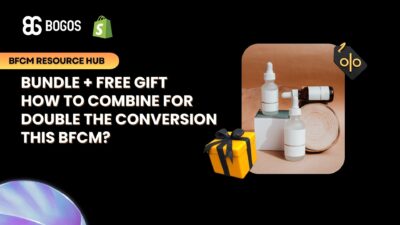
Does your BFCM sales spike quickly disappear, leaving you with a list of one-time buyers who never return? That’s...
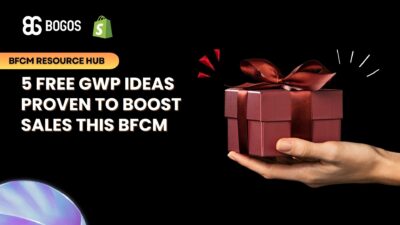
We know how tough it is to make your voice heard during the chaos of BFCM, where every brand...
